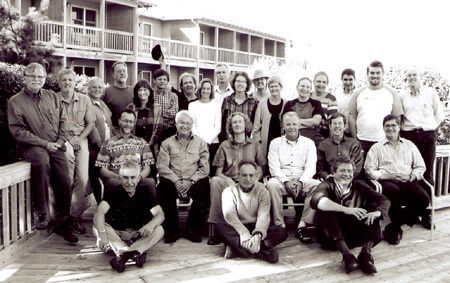Roots of Human Sociality: Culture, Cognition, and Human Interaction
Date
Oct 2-9, 2004Organized by
Nicholas J. Enfield and Stephen C. LevinsonLocation
The Sanderling Resort, Duck, North CarolinaPublications
Roots of Human Sociality: Culture, Cognition, and Interaction (Nicholas J. Enfield and Stephen C. Levinson, Eds.), Berg, Oxford, 2006.Participants
- Janet Wilde Astington University of Toronto, Canada
- Maurice Bloch London School of Economics, UK
- Robert Boyd University of California, Los Angeles, USA
- Richard Byrne University of St. Andrews, UK
- Herbert H. Clark Stanford University, USA
- Eve Danziger University of Virginia, USA
- Alessandro Duranti University of California, Los Angeles, USA
- Nicholas J. Enfield Max Planck Institute for Psycholinguistics, The Netherlands
- Richard Fox Wenner-Gren Foundation, USA
- Suzanne Gaskins Northeastern Illinois University, USA
- György Gergely Hungarian Academy of Sciences
- Susan Goldin-Meadow University of Chicago, USA
- Charles Goodwin University of California, Los Angeles, USA
- William F. Hanks University of California, Berkeley, USA
- Jane H. Hill University of Arizona, USA
- Edwin Hutchins University of California-San Diego, La Jolla, USA
- Elizabeth Keating University of Texas, USA
- Paul Kockelman Barnard College, USA
- Stephen C. Levinson Max Planck Institute for Psycholinguistics, The Netherlands
- Ulf Liszkowski Max Planck Institute for Evolutionary Anthropology, Germany
- Jennie E. Pyers University of California-San Diego, La Jolla, USA
- Federico Rossano Max Planck Institute for Psycholinguistics, The Netherlands
- Emanuel A. Schegloff University of California, Los Angeles, USA
- Catherine E. Snow Harvard University, USA
- Dan Sperber Centre National de la Recherche Scientifique, France
- Michael Tomasello Max Planck Institute for Evolutionary Anthropology, Germany
ORGANIZER’S STATEMENT: This symposium explored the idea that what lies at the heart of the uniquely human way of life is our peculiarly intense, mentally mediated and highly structured way of interacting with one another. This in turn rests on participation in a common mental world, a world in which we have detailed expectations about each other’s behavior, beliefs about what we share and do not share in the way of knowledge, intentions and motivations – that itself relies both on communication (not only through language but also through other means) and on a level of cooperation unique in the animal world. This mode of cooperative, mentally-mediated interaction makes possible the accumulation of cultural capital and historical emergence of cultures. By inheriting a world of social organizations and values, individuals are released from reinventing the wheel. In turn, cultural capital shapes the style of interaction in local social groups, hiding shared commonalities behind the veil of distinct languages, cultural styles and different social organizations.
The symposium brought together psychologists, sociologists, linguists and anthropologists whose work had not been juxtaposed before. This meeting was larger than the usual, with twenty speakers and four commentators. The precirculated papers were each presented to the group as a whole, with general discussion following. Many of the presenters included extensive empirical data, as a focus for general discussion, and to assist in the bridging of interdisciplinary boundaries. Hence more time was spent on presentation than is normal in Wenner- Gren conferences. Five distinguished commentators (Bloch, Duranti, Fox, Hill, and Snow) helped to link discussion across the sessions, and introduce issues otherwise neglected.
Several papers focused on central properties of face-to-face interaction, the arena in which human sociality is centrally exercised (Levinson, Goodwin, Clark, Schegloff). Three featured phylogenetic perspectives, Boyd and Byrne asking how key features of the human system for interaction could have evolved, and Tomasello comparing human social abilities with those of the other great apes. Several papers focused on psychological foundations of human sociality, exploring the question of just what the individual has to provide in order to pull off human interaction as we know it (Astington, Pyers), and how such capacities develop in infancy (Gergely, Liszkowski). Another set of contributors grappled with issues of cultural framing, cultural adaptation, and cultural difference, and the role sociocultural forces may play in structuring interaction and interactional expectations, and vice versa (Hanks, Danziger, Keating). Four papers explored ways in which individuals achieve convergence in their understandings, both with respect to the interpretation of specific interactions and the content of broader cultural conventions (Enfield, Hutchins, Goldin-Meadow, Sperber). Kockelman’s presentation explored the issue from a semiotic perspective.
The participants took much effort to communicate across disciplinary boundaries and lay aside the methodological qualms that often inhibit interdisciplinary discussion. This was no doubt in part due to the renowned Wenner-Gren formula for such meetings,* but in part to the joint feeling that a new and fascinating field of interdisciplinary inquiry was opening up. The new field focuses on the intersection of principles of different orders (psychological, sociological, ethological) that work together to produce an emergent system, a system of human sociality and social interaction. The resulting book will be published by Berg as part of the Wenner-Gren International Symposium Series.
Wenner-Gren Symposium #134
